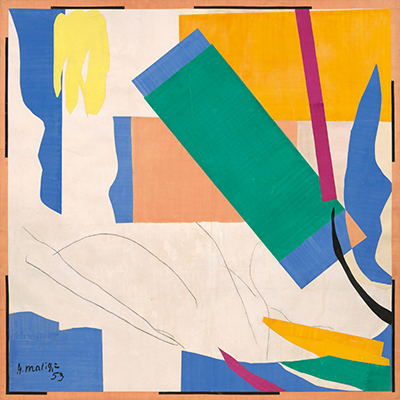Memory of Oceania is one of Henri Matisse's largest cut-out artworks. This abstract piece is nearly three metres in height and width, and makes use of gouache on paper.
This artwork is loosely dated as having been produced somewhere between the summer of 1952 and early 1953. It is now within the collection of MoMA in New York, USA. They own quite a large number of artworks from his career and is one of the best institutions from where to admire some items from his career. They also offer many of the other great names from European and American art from around the mid 19th century onwards. Each of the shapes found within Memory of Oceania were cut out by hand by Matisse from paper that had already been painted previously. He would sometimes call on assistance for that menial task, but the true genius was in how he used scissors to put together all of these different abstract shapes. Initially he would pin them on, but once they became popular he would have to prepare them to be delivered elsewhere and so started to glue elements in place instead.
Matisse had travelled to Tahiti in 1930 and the memories of that trip would inspire this particular artwork. He was perhaps inspired by Gauguin, a French painter who had embraced island life and used it within his own Post-Impressionist style. Matisse himself also took some items from Tahiti back to France and these might have helped to refresh his memory when working on Memory of Oceania two decades later. Experts have analysed the abstract shapes in this work and discovered items such as plants and flowers as well as a boat. There is also a curtain and implied window which suggests that we are looking at an abstract landscape view from a window in Tahiti, presumably somewhere that he would have stayed during his visit. Some parts of the scene have been harder to identify, however, and remain unknown.
Henri Matisse would leave behind one of the richest and most inspiring oeuvres ever produced and helped to shape the direction of modern art. He achieved so much across a variety of mediums that there is almost an endless amount of work to look through across the full span of his life. This was someone who loved to work as an artist and wanted to contine to do so right up to his death. Some of the best examples of this included the likes of Landscape at Collioure, Le Bonheur de Vivre and Portrait of Madame Matisse, the Green Line, although it is very hard to summarise this artist's achievements in just a few artworks. Many of this era would really try out different mediums and the public were also far more open minded about what constituted art than in previous centuries. Modern artists were key in challenging and developing new ideas which had the overall impact of making the industry richer and more interesting for everybody.




